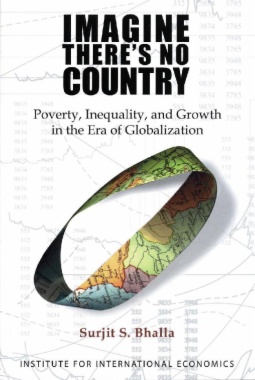A new era of globalization, which began in the 1980s, brought about a significant decline in costs of transportation, communication, and production; considerably improved intercountry competitiveness; and broke down trade and cultural barriers among countries. The concept of a sovereign nation has been increasingly questioned in recent years. Some, indeed, have imagined a world without boundaries, without countries. Others who doubt the benefits of globalization have called for increased protectionism and greater regulation of economic activity. Has globalization made the world grow faster? Has poverty declined at a faster pace during globalization? If yes, why? If not, is it because the growth rate was lower, or because inequality worsened, or both? Who gained from globalization? Was it the elite in both the developed and developing world? What about the middle class? Who are they? How did they benefit from (or lose to) the forces of globalization?
This comprehensive study firmly debunks several popular myths such as the belief that globalization has resulted in lower overall growth rates for poor countries, increasing world inequality, and stagnating poverty levels. Through rigorous, integrated methodologies and an enhanced dataset, the author, Surjit Bhalla, answers some of the most pressing policy issues confronting us today.
- Cover
- Contents
- Preface
- Acknowledgments
- Section I Received Wisdom on Poverty, Inequality, and Growth
- Chapter 1 Overview: New Results on Poverty, Inequality, and the Growth in the Era of Globalization
- The Issues
- The Framework and the Data
- A Bird's Eye View
- A More Detailed Overview
- Results on Absolute Poverty
- Results on Propoor Growth
- Has Globalization Worsened Inequality?
- Has Globalization Been Good for Poor People?
- Research and Monopolies
- Chapter 2 The Pattern of Economic Growth 1950-2000
- Data and Methods of Estimating Growth
- Global Levels of Income and Growth
- Globalization: Divergence
- Evidence of Convergence or Divergence
- Chapter 3 Inequality as We Know It
- Measuring Inequality
- Measuring Intertemporal Inequality
- Simple Inequality Mathematics
- Inequality: Kuznets Curve and Data Requirements
- Recent Evidence on Country Inequality
- The Evidence Once Again
- Tests of Inequality Change
- Elasticity of Connection, 1960-2000
- Country-Level Inequality
- Toward Individual Inequality Estimates
- Individual Inequality
- Summing Up: The Facts as We Know Them
- Chapter 4 Poverty as We Are Told It Is
- Defining and Measuring Absolute Poverty
- Poverty in the United States
- The World Bank Enters the Poverty Arena
- First Absolute Poverty Line, Estimates, and Forecasts
- The Search for an Absolute Absolute Measure
- Rediscovering the $1-a-Day Poverty Line
- The Poverty Line Reduced
- Evolving World Bank Definitions of Poverty
- Section II Discussion of Knowledge on Poverty, Inequality, and Growth and Analysis of Data and Methodologies
- Chapter 5 Taking Stock of the Facts
- The Global Pie, 1960-2000
- Inequality Trends
- Poverty Trends
- Not Propoor Growth
- Is the Conventional Wisdom Correct?
- Facts and Figures
- The Importance of Data
- Duck and Smell Tests to Differeniate
- Experts Debate
- Elasticity of the Gini with Growth
- Poverty "Smell" Tests
- The Need for Alternative Studies
- Chapter 6 Recounting Poor People
- Definitions and Methods
- Using Different PPP Exchange Rates
- Differences between World Bank Consumption and Official PPPs
- All Indians Were Dead in 1950, or 1960
- Chapter 7 Surveys and National Accounts: Can a Choice Be Made?
- What Is the Problem?
- There Is a Problem Even in the United States
- In Defense of Surveys
- What Happened to the Survey/National Accounts Ratio?
- Unintended Consequences of Moving to Survey Means
- Do National Accounts Estimates Have Problems?
- Choosing between Surveys and National Accounts
- By How Much Do Rich People Understate Expenditures?
- Estimating Undercoverage of Rich People
- The SAP $1.50 Poverty Line
- "Smell" Tests for Indian Poverty Estimates
- Should Surveys or National Accounts Be Used? Or Both?
- Chapter 8 Other Methodological Considerations
- The Individual versus Countries
- Simple Accounting Procedure for Generating W3i
- The Kakwani Method of Estimating a Lorenz Curve
- Is SAP Accurate?
- Using SAP to Identify Errors in Published Ginis
- Section III New Results on Poverty, Inequality, and Growth Based on Simple Accounting Procedure Methods
- Chapter 9 Poverty as It Is---and Forecasts for 2015
- How Much Poverty Is There in the World?
- Where Did Poverty Decline from 1960 to 2000?
- The Evolution of World Poverty, 1820-2000
- A Digression: How Do You Assess the Best?
- Regional Poverty Trends
- Time to Raise the Poverty Line
- Forecasts for 2000 and 2015
- Chapter 10 Reinventing the Kuznets Curve: Propoor Growth
- The Search for Propoor Growth
- The Growth-Poverty Connection
- Propoor Elasticity
- Propoor Mathematics
- Empirical Estimates of Propoor Growth
- Estimating Propoor Elasticity
- Has Global Growth Been Propoor?
- Using Consistent Data
- Is the Initial Income Distribution Important?
- A Simple Method for Estimating Propoor Growth
- Forecast of Poverty in 2015
- Chapter 11 Inequality as It Is
- SAP Results for World Inequality, 1950-2000
- Regions and Indices
- Individual Inequality Studies Compared
- How Accurate Are the SAP Estimates?
- Poor People Have a High Elasticity of Connection
- The Relationship between Growth and Inequality
- The Middle Class
- Chapter 12 Globalization: A Second Look
- Income: Before and After
- Convergence: New Results
- Catch-up with Globalization
- Is There a Poverty-Terrorism Connection?
- The Evolution of Living Standards, 1960-2000
- Chapter 13 Conclusion: Roads Not Taken
- Different Forks for Different Folks
- Answers to Often-Asked Questions
- Appendices
- Appendix A The Simple Accounting Procedure Dataset
- Appendix B Estimation of the Lorenz Curve, and Its Accuracy
- How Good Is SAP?
- Errors in Survey Inequality Measures
- Errors in Published Inequality Data
- Appendix C Basic Data for the Simple Accounting Procedure
- References
- Index

